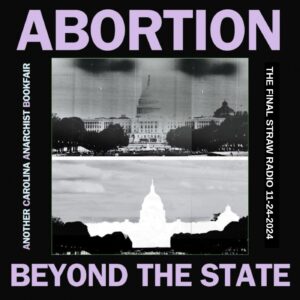
This week, we’re featuring an anonymized chat with a longtime anarchist on lessons learned trying to stay sane while facing state repression. We talk about experiencing trauma, the need for strong relationships and movements offering shelter and strong alternatives to the alienated society of state and capital, while also speaking on the challenges of mental health and inviting in new participants in anarchist movement.
Chapters:
- Introduction and Disclaimer [00:00:23]
- Post-911/Patriot Act State of Heightened Repression and build up to today [00:02:29]
- Navigating security amidst a post-social media and post-smart phone era [00:23:33]
- Creating safer and more secure revolutionary communities that can better withstand the heat [00:31:02]
- Recognizing and overcoming repression-based trauma on an individual and community level [00:40:02]
- Supporting comrades overcoming mental health episodes (spiralling) amidst repression and burnout [01:09:13]
- On infiltrators and the depths the state will go to inflict trauma, fish, and divide [01:15:57]
- Recognizing the ‘severity’ of our position, and taking ourselves seriously [01:26:22]
- Some tips on facing trauma or intimidation, or supporting others experiencing repression-related trauma [01:34:18]
Descending References and Resources List According to Interview:
Green Scare Background
- Green Scare Intro and Article References https://cldc.org/green-scare/
- Mainstream Media Story (MSM Story): The Green Scare: How a Movement That Never Killed Anyone Became the FBI’s No. 1 Domestic Terrorism Threat https://theintercept.com/2019/03/23/ecoterrorism-fbi-animal-rights/
- TFSR Interviews:
- Green Is The New Red with Will Potter: https://thefinalstrawradio.noblogs.org/post/2011/05/29/green-is-the-new-red-an-interview-with-will-potter-may-29-2011/
- Eric McDavid after his release: https://thefinalstrawradio.noblogs.org/post/2015/04/13/a-chat-with-eric-mcdavid-on-prison-post-incarceration-hope-ice-cream-more/
Grand Juries
- CLDC: Grand Juries https://cldc.org/wp-content/uploads/2014/04/CLDC-GJ-PPT-2012.ppt_-2.pdf
- Surviving a Grand Jury: Three Narratives from Grand Jury Resisters https://theanarchistlibrary.org/library/crimethinc-surviving-a-grand-jury
- People’s Law Office: The Improper Use of the Federal Grand Jury: An Instrument for the Internment of Political Activists https://peopleslawoffice.com/improper-use-of-federal-grand-jury-michael-deutsch-political-repression/
- Surviving a Grand Jury What it means to resist a grand jury; stories from those who have; how to support North Carolina grand jury resistance (PodCast) https://crimethinc.com/podcasts/the-ex-worker/episodes/59
Border Detention
- Crossing the United States Border A Security Guide for Citizens and Non-Citizens https://crimethinc.com/2020/01/28/crossing-the-united-states-border-a-security-guide-for-citizens-and-non-citizens
Police Visitation
- Center for Constitutional Rights: If An Agent Knocks Resource https://ccrjustice.org/if-agent-knocks-resource
- When the Police Knock on Your Door Your Rights and Options: A Legal Guide and Poster https://www.sproutdistro.com/2017/08/29/when-the-police-knock/
- If the FBI Approaches You to Become an Informant An FAQ: What You Need to Know https://crimethinc.com/2017/05/17/if-the-fbi-approaches-you-to-become-an-informant-an-faq-what-you-need-to-know
- National Lawyers Guild: If An Agent Knocks https://nlgsf.org/if-an-agent-knocks/
On Phone and Digital Security Culture
- Taking Ourselves Seriously: Digital Harm Reduction (PDF Format) https://www.notrace.how/resources//download/pairnontas-tis-eautous-mas-sobara-meiose-psephiakon-kindunon/taking-ourselves-seriously-digital-harm-reduction-booklet-A4.pdf
- Electronic Frontier Foundation: Mainstream Resource and Non-Profit Advocate for Digital Privacy https://www.eff.org/
Infiltration Cases:
- MSM Story on Mark Kennedy: How a Married Undercover Cop Having Sex With Activists Killed a Climate Movement https://anarchistnews.org/content/how-married-undercover-cop-having-sex-activists-killed-climate-movement
- TFSR interview on Spy Cops: https://thefinalstrawradio.noblogs.org/post/2020/11/29/uncovering-spy-cops-in-the-uk/
- MSM Story on Eric McDavid case: Manufacturing Terror: An FBI Informant Seduced Eric McDavid Into a Bomb Plot. Then the Government Lied About It. https://theintercept.com/2015/11/19/an-fbi-informant-seduced-eric-mcdavid-into-a-bomb-plot-then-the-government-lied-about-it/
- Earth First!: Informants List https://earthfirstjournal.news/informants/
Anti-Repression Resources:
- NYC Anarchist Black Cross https://nycabc.wordpress.com/
- Support Defendants & Prisoners From the George Floyd Uprisings https://uprisingsupport.org/further-resources/
- Anti-Repression, Supporting Uprising and Anarchist Prisoners https://thefinalstrawradio.libsyn.com/anti-repression-supporting-uprising-and-anarchist-prisoners
- A Tilted Guide to Being a Defendant (PDF Zine) https://files.libcom.org/files/atiltedguide-web-1.pdf
J20 Case
- Lessons from #DefendJ20 on Building Movement Defense Against Repression https://itsgoingdown.org/lessons-from-defendj20-on-building-movement-defense-against-repression/
Sobriety Discussion
- Sobriety and Anarchist Struggle (PDF Version) https://files.sproutdistro.com/towards_a_less_fucked_up_world-SCREEN.pdf
Mental Health/Trauma/Burn Out
- Survivors Manual: Surviving In Solitary (PDF) https://afsc.org/sites/default/files/documents/Survivors%20Manual_0.pdf
- Sub.Media: Redefining Sanity Through Struggle https://sub.media/trouble-17-mad-worlds/
- Conflictual Wisdom: On Burning Out and Anarchist Self-Preservation https://itsgoingdown.org/announcing-publication-conflictual-wisdom/
- Against the Struggle of the Coward: A Note of Strength for the Underdogs https://itsgoingdown.org/against-the-struggle-of-the-coward-a-note-of-strength-for-the-underdogs/
- Repression, Resiliency, & Movement Support: An Interview https://itsgoingdown.org/bloc-party-interview-repression-resiliency/
- Solidarity Apothecary (PodCast) https://solidarityapothecary.org/
- Broader Wellness Resources by Mutual Aid Disaster Relief https://mutualaiddisasterrelief.org/health-wellness/
- Trauma & Recovery Brochure (PDF) https://www.sproutdistro.com/catalog/zines/direct-action/actvist-trauma-recovery/
- Solidarity Is Greater Than Fear: Lessons from G20 to Stop Cop City (Youtube Link) https://www.youtube.com/watch?v=DMObMCCgWjI
- A Life Worth Living: Care, Survival, Suicide, and Grief (Zine Resource on the Subjects) https://lizzieanderson.com/wp-content/uploads/2023/06/a-life-worth-living-print-final.pdf
. … . ..
Featured Track:
- Hold Onto Each Other by Thee Silver Mt. Zion Memorial Orchestra & Tra-La-La Band from Horses In The Sky

